Light Propagation in Confined Nematic Liquid Crystals and Device Applications
Abstract
:Featured Applications
Abstract
1. Introduction
2. Materials and LC Waveguide Structures
2.1. Nematic LC Confined in SiO2/Si V-grooves
2.2. Nematic LC in PDMS Waveguides
3. Modelling of Light Propagation in Nematic LC Waveguides
4. Device Applications
4.1. On-Off Optical Switch and Variable Optical Attenuator
4.2. Electro-Optic Router
4.3. Nematic LC Electrically Tunable Bragg Reflectors
5. Conclusions
Author Contributions
Funding
Conflicts of Interest
References
- Khoo, I.C. Liquid Crystals, 2nd ed.; Wiley: New York, NY, USA, 2007. [Google Scholar]
- Zografopoulos, D.C.; Asquini, R.; Kriezis, E.; D’Alessandro, A.; Beccherelli, R. Guided-wave liquid-crystal photonics. Lab A Chip 2012, 12, 3598–3610. [Google Scholar] [CrossRef]
- Beeckman, J.; Neyts, K.; Vanbrabant, P.J.M. Liquid-crystal photonic applications. Opt. Eng. 2011, 50, 081202. [Google Scholar] [CrossRef] [Green Version]
- Donisi, D.; Bellini, B.; Beccherelli, R.; Asquini, R.; Gilardi, G.; Trotta, M.; D’Alessandro, A. A Switchable Liquid-Crystal Optical Channel Waveguide on Silicon. IEEE J. Quantum Electron. 2010, 46, 762–768. [Google Scholar] [CrossRef]
- d’Alessandro, A.; Asquini, R.; Trotta, M.; Gilardi, G.; Beccherelli, R.; Khoo, I.C. All-optical intensity modulation of near infrared light in a liquid crystal channel waveguide. Appl. Phys. Lett. 2010, 97, 093302. [Google Scholar] [CrossRef]
- Neyts, G.K.; Beeckman, J.; Desmet, H. Waveguiding with liquid crystals. Proc. SPIE 2007, 6487, 64870O. [Google Scholar]
- Scalia, G.; Hermann, D.S.; Abbate, G.; Komitov, L.; Mormile, P.; Righini, G.C.; Sirleto, L. Integrated Electro-Optic Switch Based on a Ferroelectric Liquid Crystal Waveguide. Mol. Cryst. Liq. Cryst. 1998, 320, 321–335. [Google Scholar] [CrossRef]
- d’Alessandro, A.; Bellini, B.; Donisi, D.; Beccherelli, R.; Asquini, R. Nematic liquid crystal optical channel waveguides on silicon. IEEE J. Quant. Electron. 2006, 42, 1084–1090. [Google Scholar] [CrossRef]
- Peddireddy, K.; Jampani, V.S.R.; Thutupalli, S.; Herminghaus, S.; Bahr, C.; Muševič, I. Lasing and waveguiding in smectic A liquid crystal optical fibers. Opt. Express 2013, 21, 30233–30242. [Google Scholar] [CrossRef]
- Čančula, M.; Ravnik, M.; Muševič, I.; Žumer, S. Liquid microlenses and waveguides from bulk nematic birefringent profiles. Opt. Express 2016, 19, 22177–22188. [Google Scholar] [CrossRef]
- Xing, Y.; Ako, T.; George, J.P.; Korn, D.; Yu, H.; Verheyen, P.; Pantouvaki, M.; Lepage, G.; Absil, P.; Ruocco Koos, C.; et al. Digitally Controlled Phase Shifter Using an SOI Slot Waveguide with Liquid Crystal Infiltration. IEEE Photon. Technol. Lett. 2015, 27, 1269–1272. [Google Scholar] [CrossRef]
- Wang, T.-J.; Chaung, C.-K.; Li, W.-J.; Chen, T.-J.; Chen, B.-Y. Electrically Tunable Liquid-Crystal-Core Optical Channel Waveguide. J. Light. Technol. 2013, 31, 3570–3574. [Google Scholar] [CrossRef]
- Li, J.; Chu, D. Liquid Crystal-Based Enclosed Coplanar Waveguide Phase Shifter for 54–66 GHz Applications. Crystals 2019, 9, 650. [Google Scholar] [CrossRef] [Green Version]
- Reese, R.; Polat, E.; Tesmer HStrobl, J.; Schuster, C.; Nickel, M.; Granja, A.B.; Jakoby, R.; Maune, H. Liquid Crystal Based Dielectric Waveguide Phase Shifters for Phased Arrays at W-Band. IEEE Access 2019, 7, 127032–127041. [Google Scholar] [CrossRef]
- Tripathi, U.S.; Rastogi, V. Liquid Crystal Based Rib Waveguide. J. Lightw. Technol. 2020, 38, 4045–4051. [Google Scholar] [CrossRef]
- Assanto, G.; Peccianti, M.; Conti, C. Nematicons: Optical Spatial Solitons in Nematic Liquid Crystals. Opt. Photon-News 2003, 14, 44–48. [Google Scholar] [CrossRef]
- Henninot, J.-F.; Blach, J.-F.; Warenghem, M. Experimental study of the nonlocality of spatial optical solitons excited in nematic liquid crystal. J. Opt. A Pure Appl. Opt. 2007, 9, 20–25. [Google Scholar] [CrossRef]
- Assanto, G.; Fratalocchi, A.; Peccianti, M. Spatial solitons in nematic liquid crystals. Opt. Exp. 2007, 15, 5248–5259. [Google Scholar] [CrossRef]
- Piccardi, A.; Alberucci, A.; Bortolozzo, U.; Residori, S.; Assanto, G. Soliton gating and switching in liquid crystal light valve. Appl. Phys. Lett. 2010, 96, 071104. [Google Scholar] [CrossRef]
- Piccardi, A.; Trotta, M.; Kwasny, M.; Alberucci, A.; Asquini, R.; Karpierz, M.; D’Alessandro, A.; Assanto, G. Trends and trade-offs in nematicon propagation. Appl. Phys. A 2011, 104, 805–811. [Google Scholar] [CrossRef]
- Jung, P.S.; Krolikowski, W.; Laudyn, U.A.; Trippenbach, M.; Karpierz, M. Supermode spatial optical solitons in liquid crystals with competing nonlinearities. Phys. Rev. A 2017, 95, 023820. [Google Scholar] [CrossRef] [Green Version]
- Aya, S.; Araoka, F. Kinetics of motile solitons in nematic liquid crystals. Nat. Commun. 2020, 11, 3248. [Google Scholar] [CrossRef] [PubMed]
- Du, F.; Lu, Y.-Q.; Wu, S.-T. Electrically tunable liquid-crystal photonic crystal fiber. Appl. Phys. Lett. 2004, 85, 2181–2183. [Google Scholar] [CrossRef] [Green Version]
- Woliński, T.; Ertman, S.; Lesiak, P.; Domański, A.; Czapla, A.; Dąbrowski, R.; Nowinowski-Kruszelnicki, E.; Wójcik, J. Photonic liquid crystal fibers—A new challenge for fiber optics and liquid crystals photonics. Opto-Electron. Rev. 2006, 14, 329–334. [Google Scholar] [CrossRef]
- Lee, C.; Chen, C.; Kao, C.; Yu, C.; Yeh, S.; Cheng, W.; Lin, T. Photo and electrical tunable effects in photonic liquid crystal fiber. Opt. Express 2010, 18, 2814–2821. [Google Scholar] [CrossRef] [PubMed]
- Lorenz, A.; Kitzerow, H.-S. Efficient electro-optic switching in a photonic liquid crystal fiber. Appl. Phys. Lett. 2011, 98, 241106. [Google Scholar] [CrossRef]
- Budaszewski, D.; Chychłowski, M.; Budaszewska, A.; Bartosewicz, B.; Jankiewicz, B.; Wolinski, T. Enhanced efficiency of electric field tunability in photonic liquid crystal fibers doped with gold nanoparticles. Opt. Express 2019, 27, 14260–14269. [Google Scholar] [CrossRef] [PubMed]
- Vasdekis, A.; Cuennet, J.G.; Psaltis, D. Liquid crystal optofluidics. Proc. SPIE 2012, 847507. [Google Scholar] [CrossRef]
- De Sio, L.; Romito, M.; Giocondo, M.; Vasdekis, A.; De Luca, A.; Umeton, C. Electro-switchable polydimethylsiloxane-based optofluidics. Lab A Chip 2012, 12, 3760–3765. [Google Scholar] [CrossRef]
- Cuennet, J.G.; Vasdekis, A.E.; Psaltis, D. Optofluidic-tunable color filters and spectroscopy based on liquid-crystal microflows. Lab Chip 2013, 13, 2721–2726. [Google Scholar] [CrossRef] [Green Version]
- d’Alessandro, A.; Martini, L.; Gilardi, G.; Beccherelli, R.; Asquini, R. Polarization-Independent Nematic Liquid Crystal Waveguides for Optofluidic Applications. IEEE Photonics Technol. Lett. 2015, 27, 1709–1712. [Google Scholar] [CrossRef]
- Čopar, S.; Kos, Ž.; Emeršič, T.; Tkalec, U. Microfluidic control over topological states in channel-confined nematic flows. Nat. Commun. 2020, 11, 59. [Google Scholar] [CrossRef] [PubMed]
- Ramaniuk, A.; Jung, P.S.; Christodoulides, D.N.; Krolikowski, W.; Trippenbach, M. Absorption-mediated stabilization of nonlinear propagation of vortex beams in nematic liquid crystals. Opt. Commun. 2019, 451, 338–344. [Google Scholar] [CrossRef]
- Laudyn, U.A.; Kwaśny, M.; Karpierz, M.A.; Assanto, G. Vortex nematicons in planar cells. Opt. Express 2020, 28, 8282–8290. [Google Scholar] [CrossRef] [PubMed]
- Jung, P.S.; Krolikowski, W.; Laudyn, U.A.; Karpierz, M.A.; Trippenbach, M. Semi-analytical approach to supermode spatial solitons formation in nematic liquid crystals. Opt. Express 2017, 25, 23893–23898. [Google Scholar] [CrossRef] [PubMed]
- Ramaniuk, A.; Trippenbach, M.; Jung, P.S.; Christodoulides, D.N.; Krolikowski, W.; Assanto, G. Scalar and vector su-permode solitons owing to competing nonlocal nonlinearities. Opt. Express 2021, 29, 8015–8023. [Google Scholar] [CrossRef]
- Piccirillo, B.; Toscano, C.; Vetrano, F.; Santamato, E. Orbital and Spin Photon Angular Momentum Transfer in Liquid Crystals. Phys. Rev. Lett. 2001, 86, 2285. [Google Scholar] [CrossRef]
- Slussarenko, S.; Murauski, A.; Du, T.; Chigrinov, V.; Marrucci, L.; Santamato, E. Tunable liquid crystal q-plates with arbitrary topological charge. Opt. Express 2011, 19, 4085–4090. [Google Scholar] [CrossRef] [PubMed] [Green Version]
- Keum, C.; Liu, S.; Al-Shadeedi, A.; Kaphle, V.; Callens, M.K.; Han, L.; Neyts, K.; Zhao, H.; Gather, M.C.; Bunge, S.D.; et al. Tuning charge carrier transport and optical birefringence in liquid-crystalline thin films: A new design space for organic light-emitting diodes. Sci. Rep. 2018, 8, 699. [Google Scholar] [CrossRef] [Green Version]
- Lei, X.; Wieschendorf, C.; Firth, J.; Ladouceur, F.; Fuerbach, A.; Silvestri, L. Numerical modelling and optimization of actively Q-switched waveguide lasers based on liquid crystal transducers. Opt. Express 2019, 27, 8777–8791. [Google Scholar] [CrossRef]
- Belmonte, C.; Frasunkiewicz, L.; Czyszanowski, T.; Thienpont, H.; Beeckman, J.; Neyts, K.; Panajotov, K. Optimization of electrically tunable VCSEL with intracavity nematic liquid crystal. Opt. Express 2015, 23, 15706–15715. [Google Scholar] [CrossRef] [Green Version]
- Pfeifle, J.; Alloatti, L.; Freude, W.; Leuthold, J.; Koos, C. Silicon-organic hybrid phase shifter based on a slot waveguide with a liquid-crystal cladding. Opt. Express 2012, 20, 15359–15376. [Google Scholar] [CrossRef]
- Henninot, J.F.; Debailleul, M.; Asquini, R.; d’Alessandro, A.; Warenghem, M. Self-waveguiding in an isotropic channel induced in dye doped nematic liquid crystal and a bent self-waveguide. J. Opt. A: Pure Appl. Opt. 2004, 6, 315–323. [Google Scholar] [CrossRef]
- Bellini, B.; Larchanché, J.-F.; Vilcot, J.-P.; DeCoster, D.; Beccherelli, R.; D’Alessandro, A. Photonic devices based on preferential etching. Appl. Opt. 2005, 44, 7181–7186. [Google Scholar] [CrossRef] [PubMed]
- Bellini, B.; d’Alessandro, A.; Beccherelli, R. A method for butt-coupling optical fibers to liquid crystal planar waveguides. Opt. Mater. 2007, 29, 1019–1022. [Google Scholar] [CrossRef]
- Chigrinov, V.G.; Kozenkov, V.M.; Kwok, H.-S. Photoalignment of Liquid Crystalline Materials: Physics and Applications; Wiley: New York, NY, USA, 2008. [Google Scholar]
- Schadt, M. Liquid creystal displays, LC materials and LPP photoalignment. Mol. Cryst. Liq. Cryst. 2017, 320, 253–268. [Google Scholar] [CrossRef] [Green Version]
- Duffy, D.C.; McDonald, J.C.; Schueller, O.J.A.; Whitesides, G.M. Rapid Prototyping of Microfluidic Systems in Poly(dimethylsiloxane). Anal. Chem. 1998, 70, 4974–4984. [Google Scholar] [CrossRef] [PubMed]
- Lee, L.-H. Enhancement of surface wettability of adhesive silicone rubber by oxidation. J. Adhes. 1972, 4, 39–49. [Google Scholar] [CrossRef]
- Du, P.; Lin, X.; Zhang, X. Dielectric constants of PDMS nanocomposites using conducting polymer nanowires. In Proceedings of the 16th International Solid-State Sensors, Actuators and Microsystems Conference, Beijing, China, 5–9 June 2011; pp. 645–648. [Google Scholar]
- Wang, Z.; Volinsky, A.A.; Gallant, N.D. Crosslinking effect on polydimethylsiloxane elastic modulus measured by custom-built compression instrument. J. Appl. Polym. Sci. 2014, 131, 41050. [Google Scholar] [CrossRef] [Green Version]
- McDonald, J.C.; Duffy, D.C.; Anderson, J.R.; Chiu, D.T.; Wu, H.; Schueller, O.J.; Whitesides, G.M. Fabrication of microfluidic systems in poly(dimethylsiloxane). Electrophoresis 2000, 21, 27–40. [Google Scholar] [CrossRef]
- Missinne, J.; Kalathimekkad, S.; Van Hoe, B.; Bosman, E.; Vanfleteren, J.; Van Steenberge, G. Stretchable optical waveguides. Opt. Express 2014, 22, 4168–4179. [Google Scholar] [CrossRef] [Green Version]
- Yeh, P.; Gu, C. Optics of Liquid Crystal Displays; Wiley: New York, NY, USA, 1999. [Google Scholar]
- Lebwohl, P.A.; Lasher, G. Nematic-Liquid-Crystal Order—A Monte Carlo Calculation. Phys. Rev. A 1972, 6, 426–429. [Google Scholar] [CrossRef]
- Pasini, P.; Chiccoli, C.; Zannoni, C. Advances in the Computer Simulations of Liquid Crystals; Kluwer: Dordrecht, Germany, 2000. [Google Scholar]
- D’Alessandro, A.; Asquini, R.; Chiccoli, C.; Pasini, P.; Zannoni, C. Liquid crystal channel waveguides: A computer simulation of the application of transversal external fields. Mol. Cryst. Liq. Cryst. 2017, 649, 79–85. [Google Scholar] [CrossRef]
- d’Alessandro, A.; D’Orazio, A.; Campoli, F.; Petruzzelli, V.; Chessa, G.; Maltese, P. Design of an Ultrashort Directional Coupler with an SSFLC Coupling Layer. Mol. Cryst. Liq. Cryst. 1998, 320, 355–364. [Google Scholar] [CrossRef]
- Asquini, R.; D’Alessandro, A. BPM Analysis of an Integrated Optical Switch using Polymeric Optical Waveguides and SSFLC at 1.55 µm. Mol. Cryst. Liq. Cryst. 2002, 375, 243–251. [Google Scholar] [CrossRef]
- Vanbrabant, P.J.M.; Beeckman, J.; Neyts, K.; James, R.; Fernandez, F.A. A finite element beam propagation method for simulation of liquid crystal devices. Opt. Express 2009, 17, 10895–10909. [Google Scholar] [CrossRef] [PubMed]
- Asquini, R.; Fratalocchi, A.; D’Alessandro, A.; Assanto, G. Electro-optic routing in a nematic liquid-crystal waveguide. Appl. Opt. 2005, 44, 4136–4143. [Google Scholar] [CrossRef] [PubMed]
- Fratalocchi, A.; Asquini, R.; Assanto, G. Integrated electro-optic switch in liquid crystals. Opt. Express 2005, 13, 32–37. [Google Scholar] [CrossRef]
- Asquini, R.; Chiccoli, C.; Pasini, P.; Civita, L.; D’Alessandro, A. Low power photonic devices based on electrically controlled nematic liquid crystals embedded in poly (dimethylsiloxane). Liq. Cryst. 2018, 45, 2174–2183. [Google Scholar] [CrossRef]
- Asquini, R.; Gilardi, G.; D’Alessandro, A.; Assanto, G. Integrated Bragg reflectors in low-index media: Enabling strategies for wavelength tunability in electro-optic liquid crystals. Opt. Eng. 2011, 50, 71108. [Google Scholar] [CrossRef]
- Asquini, R.; D’Alessandro, A. Tunable photonic devices based on liquid crystals and composites. Proc. SPIE 2013, 8828, 88280T. [Google Scholar] [CrossRef]
- Donisi, D.; Asquini, R.; d’Alessandro, A.; Assanto, G. Distributed feedback grating in liquid crystal waveguide: A novel approach. Opt. Express 2009, 17, 5251–5256. [Google Scholar] [CrossRef] [PubMed]
- Gilardi, G.; Asquini, R.; d’Alessandro, A.; Assanto, G. Widely tunable electro-optic distributed Bragg reflector in liquid crystal waveguide. Opt. Express 2010, 18, 11524–11529. [Google Scholar] [CrossRef] [PubMed]
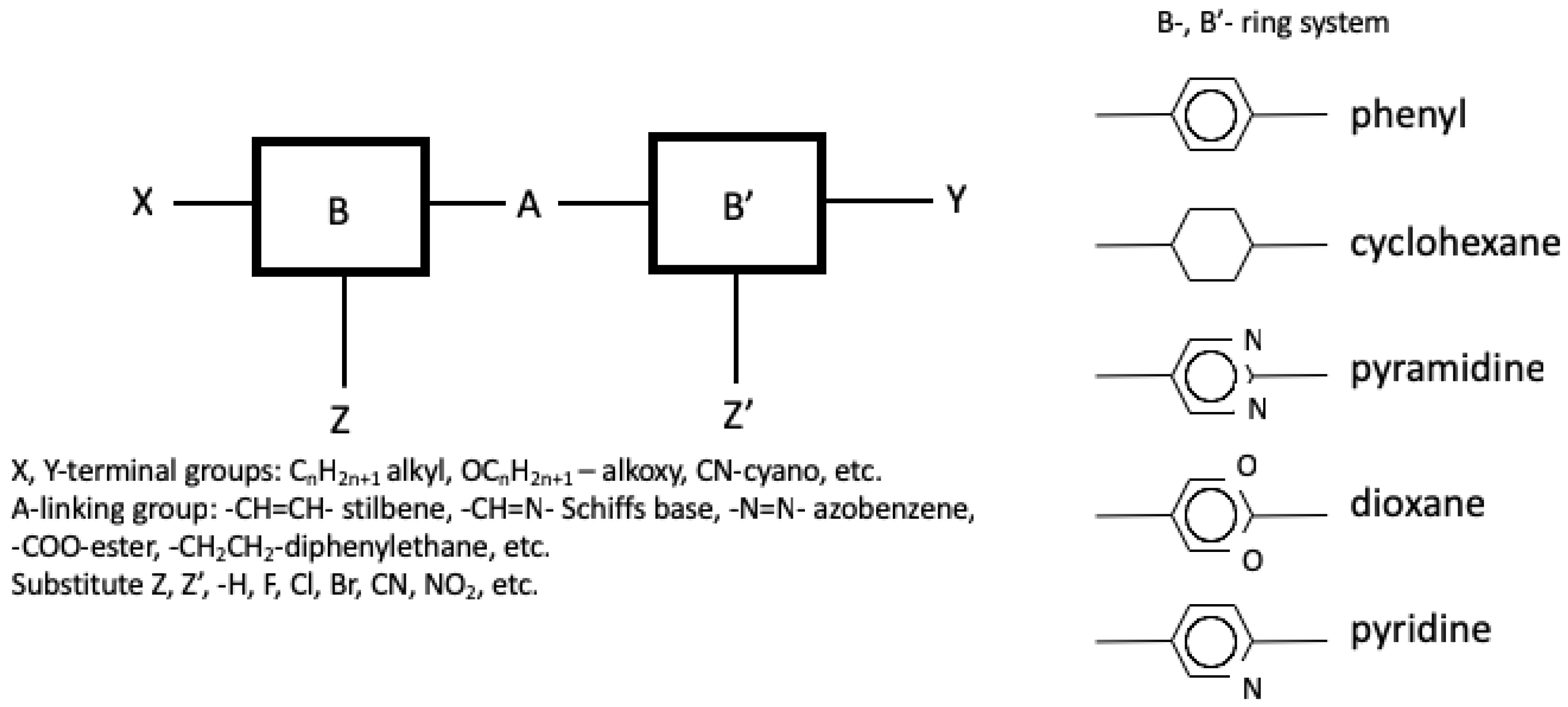

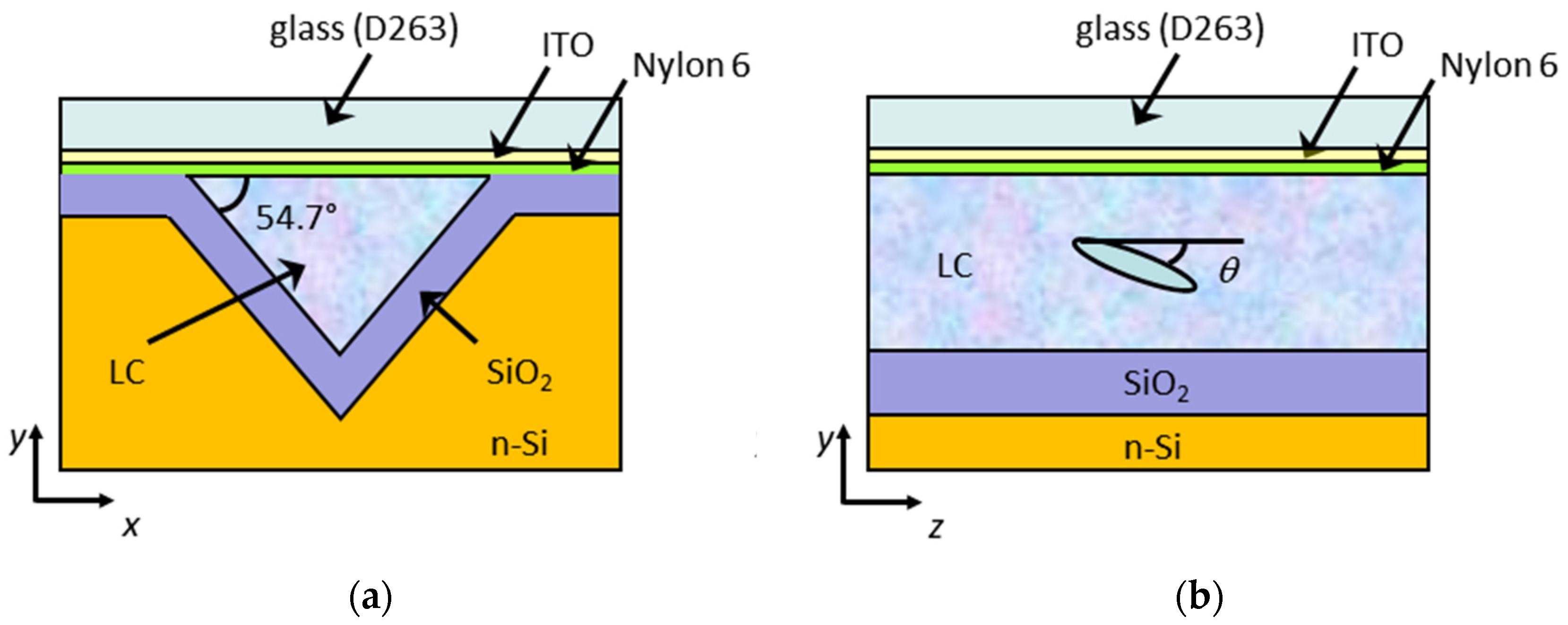




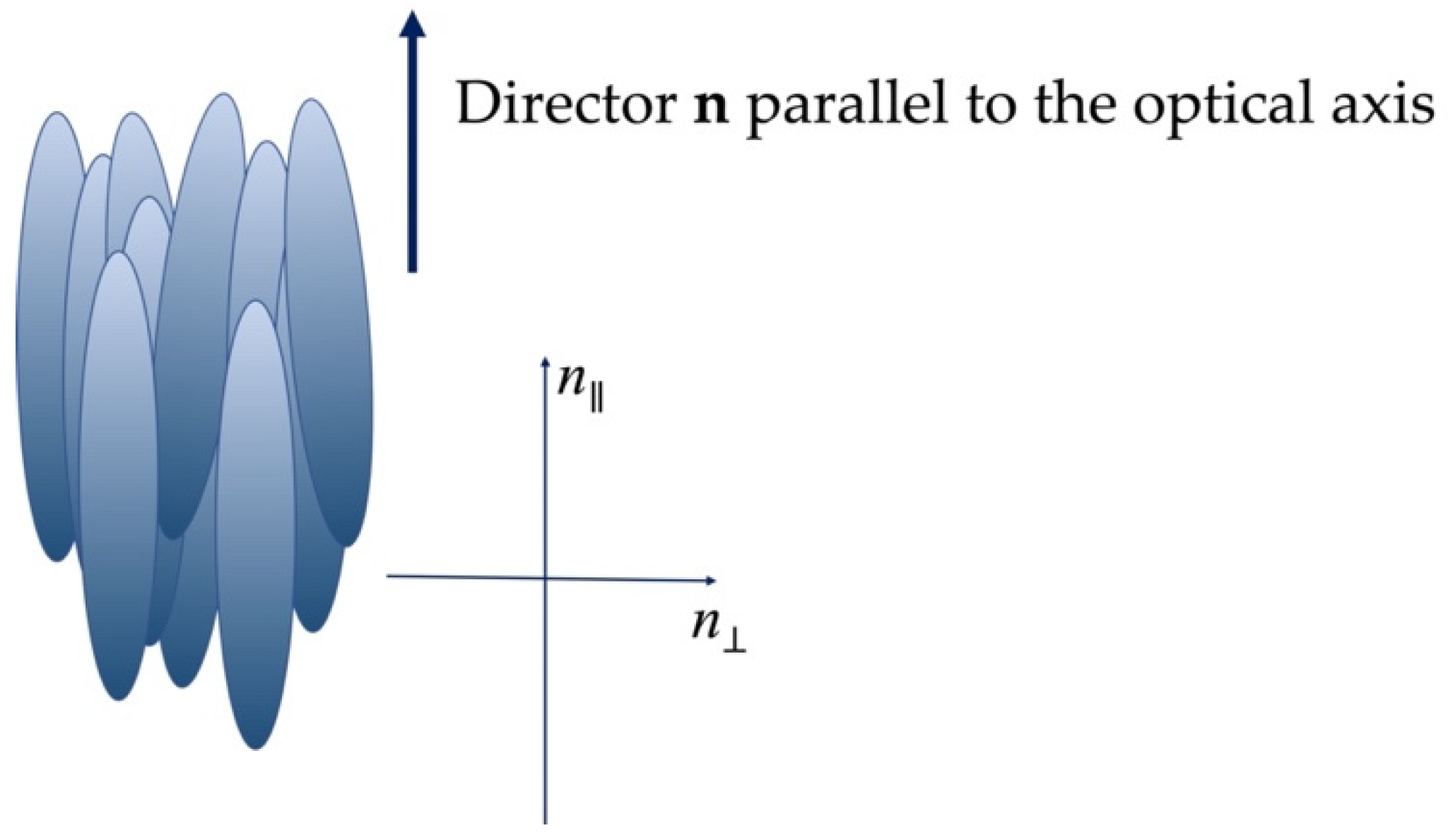
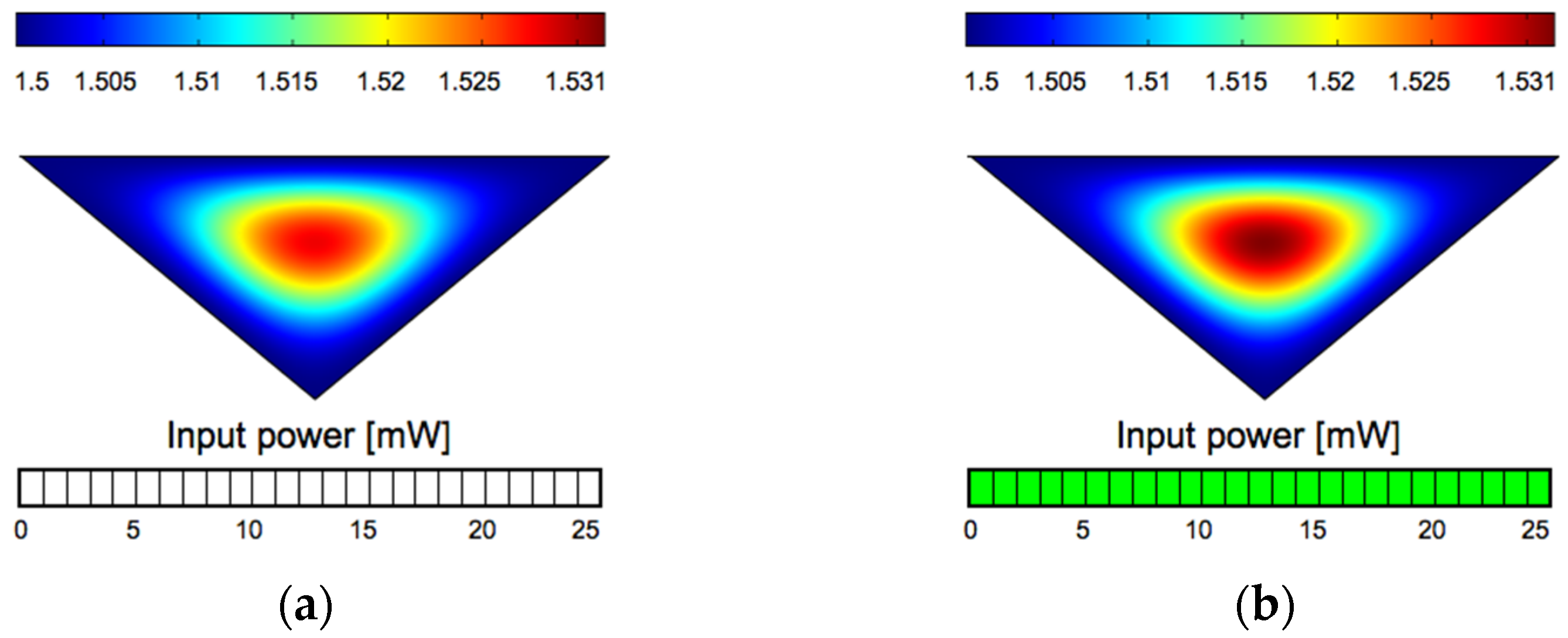

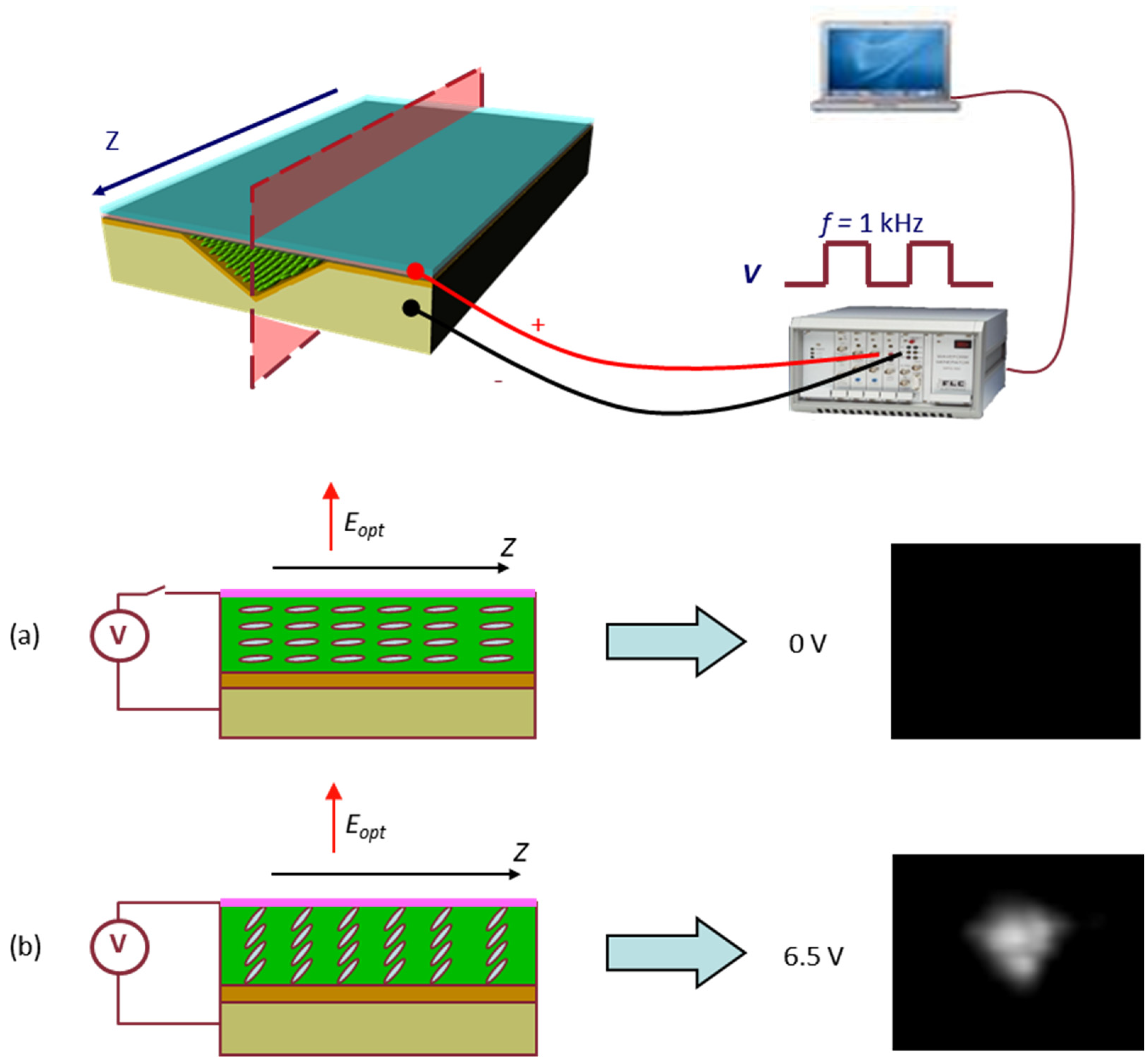

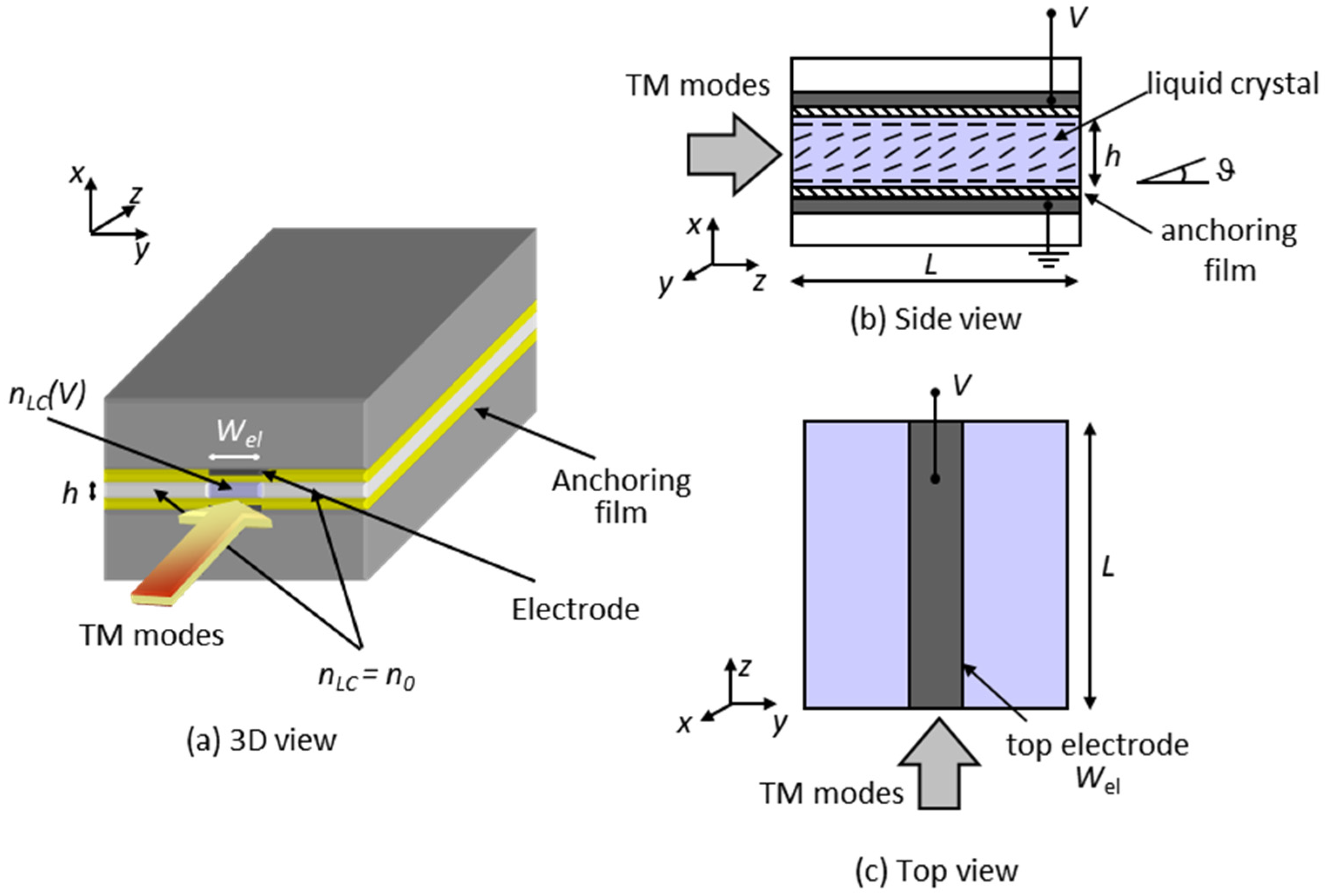
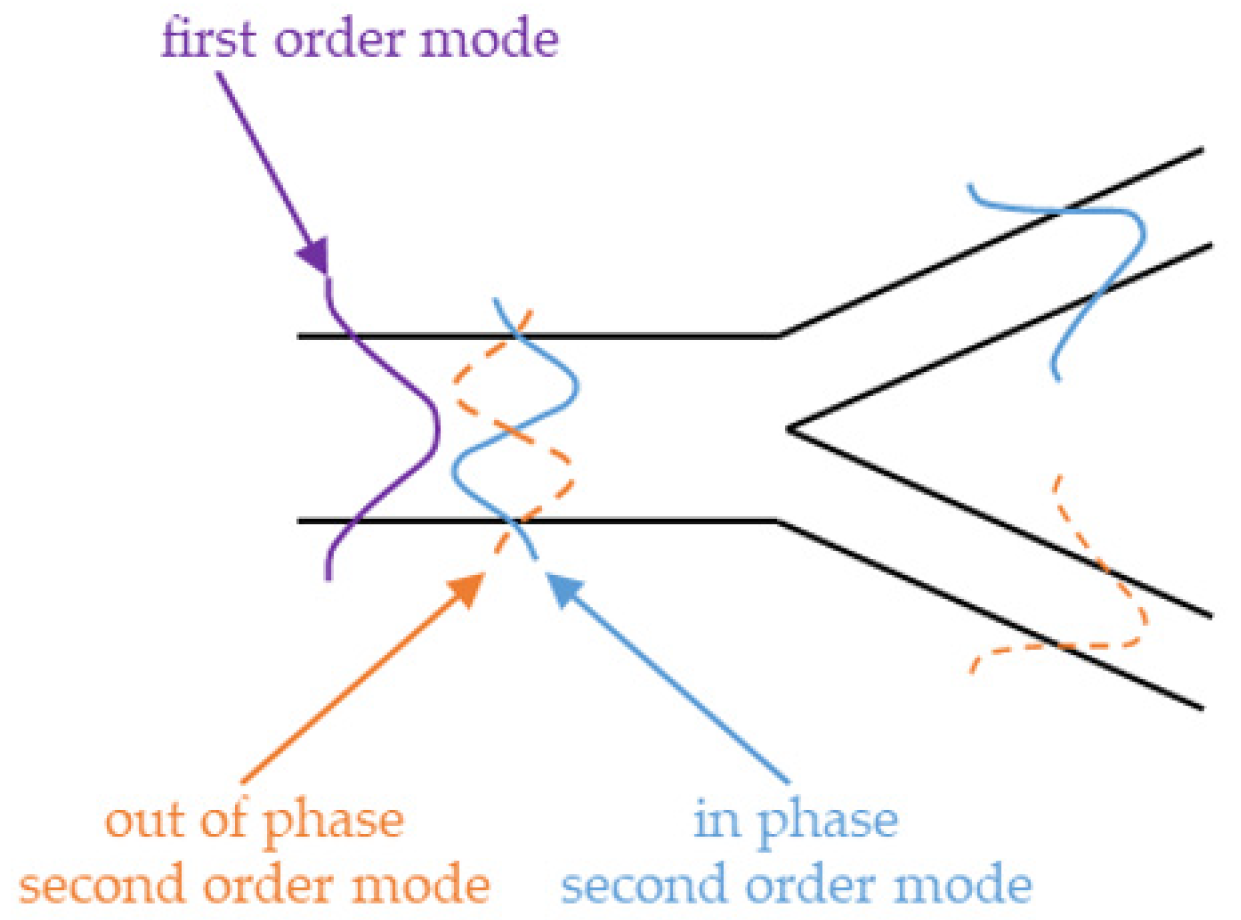
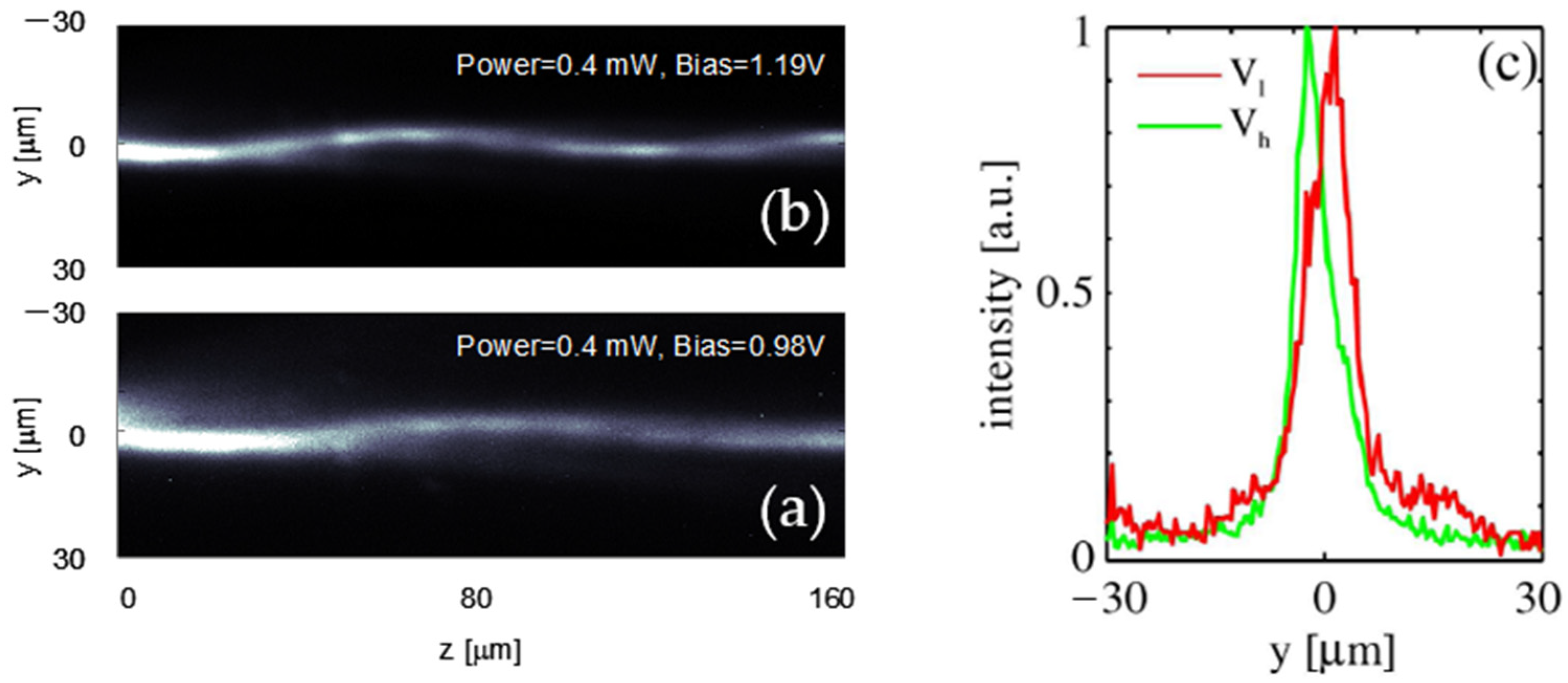


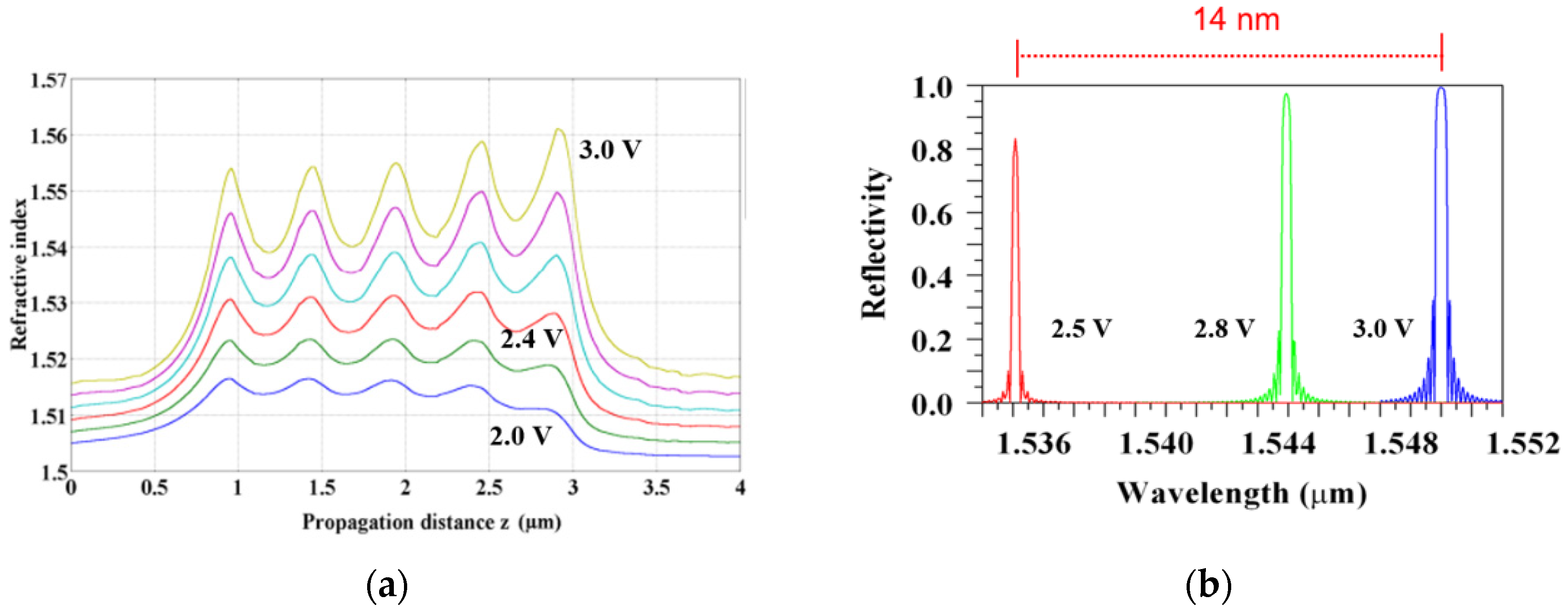
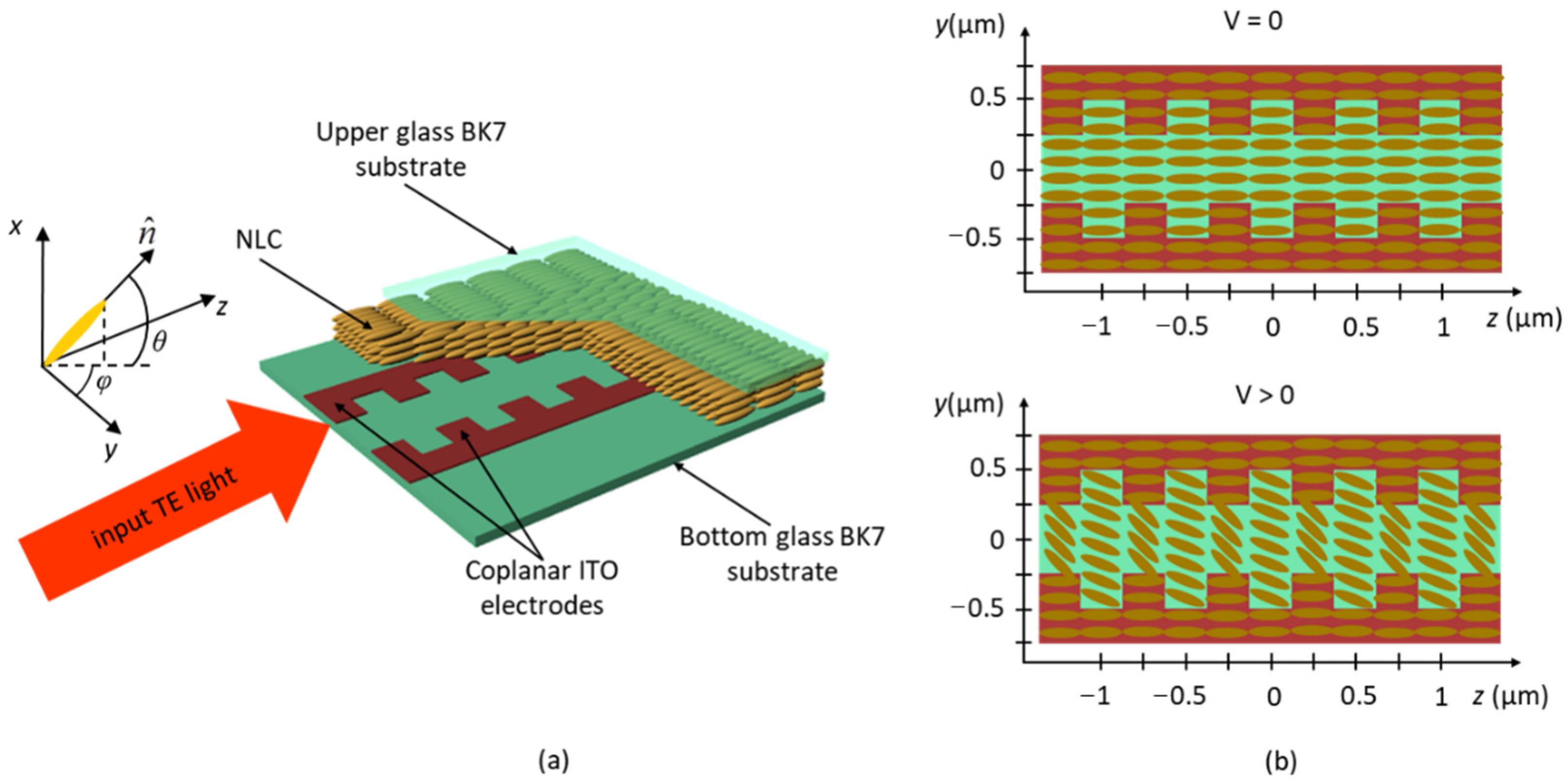
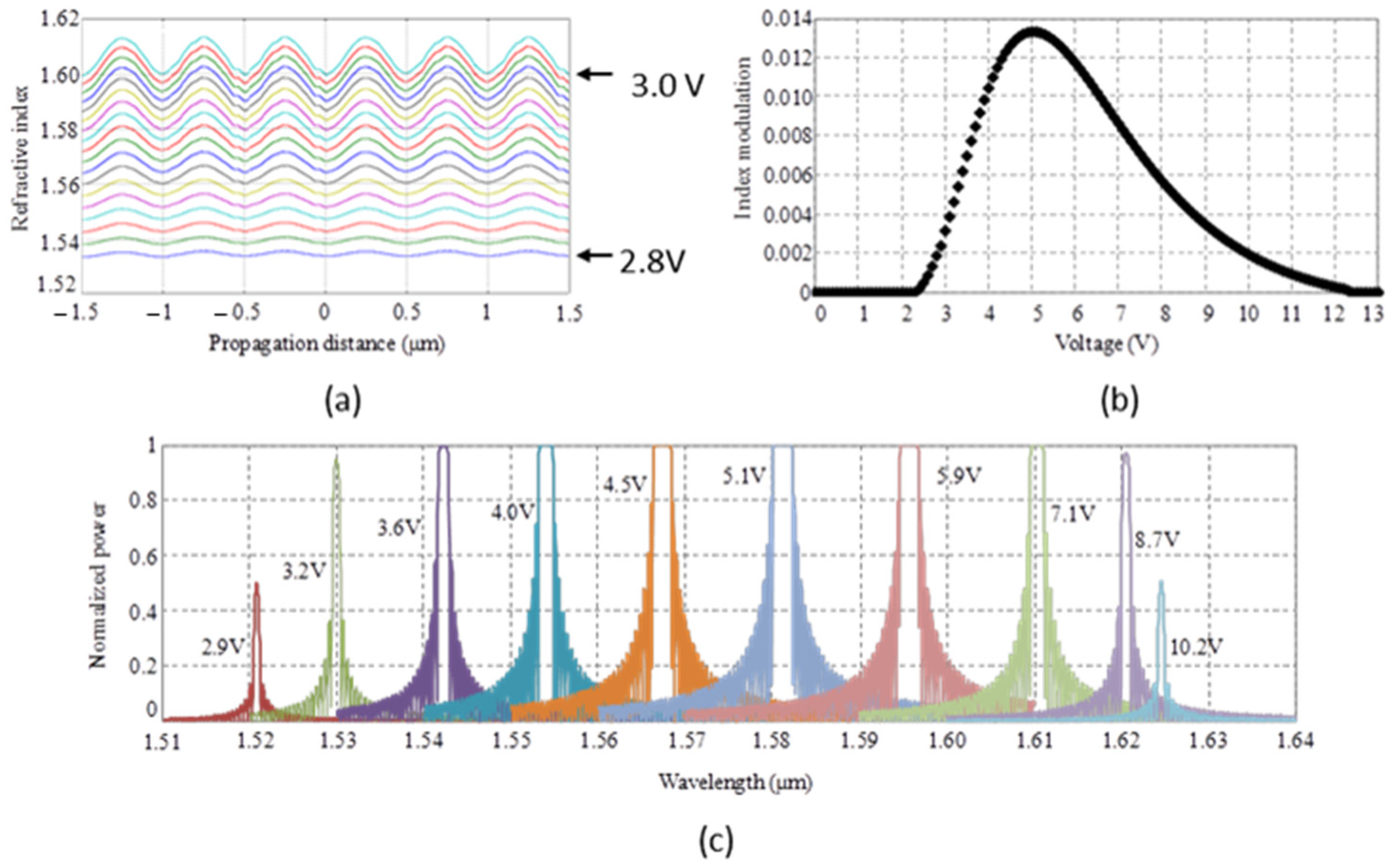
Publisher’s Note: MDPI stays neutral with regard to jurisdictional claims in published maps and institutional affiliations. |
© 2021 by the authors. Licensee MDPI, Basel, Switzerland. This article is an open access article distributed under the terms and conditions of the Creative Commons Attribution (CC BY) license (https://creativecommons.org/licenses/by/4.0/).
Share and Cite
d’Alessandro, A.; Asquini, R. Light Propagation in Confined Nematic Liquid Crystals and Device Applications. Appl. Sci. 2021, 11, 8713. https://doi.org/10.3390/app11188713
d’Alessandro A, Asquini R. Light Propagation in Confined Nematic Liquid Crystals and Device Applications. Applied Sciences. 2021; 11(18):8713. https://doi.org/10.3390/app11188713
Chicago/Turabian Styled’Alessandro, Antonio, and Rita Asquini. 2021. "Light Propagation in Confined Nematic Liquid Crystals and Device Applications" Applied Sciences 11, no. 18: 8713. https://doi.org/10.3390/app11188713
APA Styled’Alessandro, A., & Asquini, R. (2021). Light Propagation in Confined Nematic Liquid Crystals and Device Applications. Applied Sciences, 11(18), 8713. https://doi.org/10.3390/app11188713






